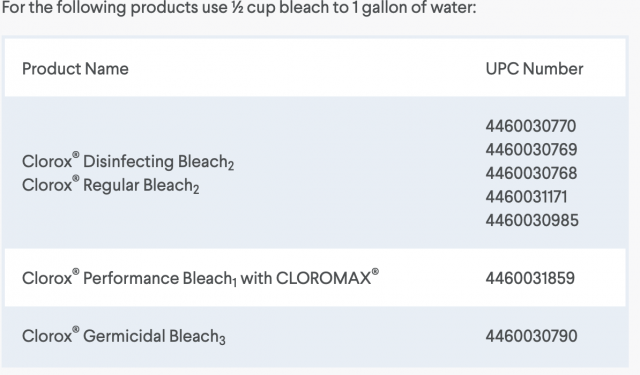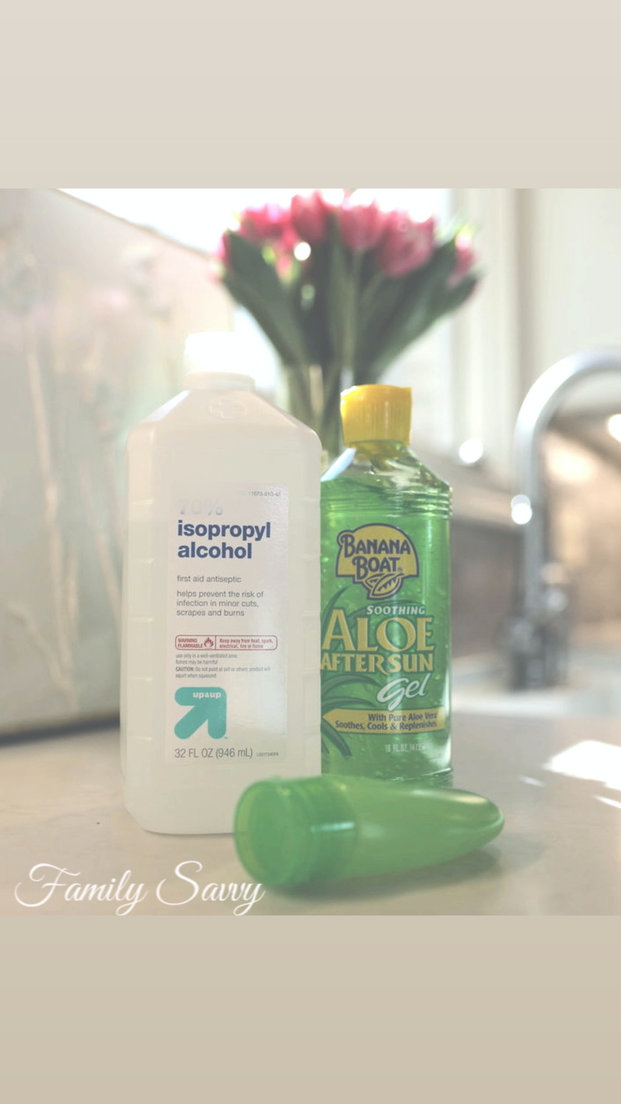How to Make Clorox Bleach Wipes & DIY Hand Sanitizer (+ Advice From a Doctor)
Here’s how to make virus killing clorox bleach wipes and hand sanitizer and advice from Dr. Jo Herzog on how to avoid contracting the coronavirus.
Update-April 12, 2020
Regarding shelf life for homemade bleach disinfection solutions.
In a product usage guide on the Clorox website, there is a Q & A regarding how often to make a new solution. This is the gist of the answer.
When you are cleaning up after things that are highly likely to spread bacteria (like raw meat), you would want to use a freshly mixed solution. smaller amount (2 tablespoons diluted in 4 cups water) that you use up over several days for general countertop cleaning.
the full article can be found here on the clorox website.
I sent the above info to Dr. Jo, and her comments are below. This is her opinion, not medical advice or a prescription.
Dr. Jo’s opinion: They are saying they don’t really know how long lasts so if you want to be super sure for really important things mix fresh . I would say if at normal temperature and not in light can probably last few days but not weeks.It is so cheap and easy to make should not be big deal . I am using same one for like a week and think fine for countertops and boxes etc. if I was cleaning a room with sick person or bathroom where someone vomiting, it would be different.
My opinion. What this means for wipes: only make enough wipes to use in the course of a day. If making this solution for disinfecting, just make what you need for the day.
What this means for the cleaning solution: For general cleaning, I plan to mix a quart to use for the week for general cleaning. If I feel the need to disinfect, I will mix a smaller amount for one 24 hour period.
UPDATE-APRIL 9, 2020
Hello friends. I had a phone conversation with Dr. Jo this morning. Hand sanitizer is almost impossible to find now. Here are some helpful tips and reminders from Dr. Jo.
- Hand sanitizer is NOT necessary at home. To quote Dr. Jo, If you have soap, water, and a sink, that is all you need; hand sanitizer is for when you don’t have these.
- Hand sanitizer does NOT require aloe. Straight alcohol (70% or higher) can be sprayed on hands from inexpensive bottle. This will kill 99% of anything on hands. It will just be very harsh on skin.
How to Use Straight Alcohol as Sanitizer
Dr. Jo shared her latest tips on using straight alcohol as a hand sanitizer if you cannot find hand sanitizer or aloe.
- Use spray bottles ($ Tree is fine; get several for everyone to use).
- Fill with 70% isopropyl alcohol. This is plenty strong; higher will be very harsh on hands.
- Let alcohol dry on hands.
- Apply moisturizer to hands. Rinsing not necessary.
- Repeat spraying after touching things or getting hands dirty.
UPDATE-APRIL 5, 2020
Dr. Jo gave me a helpful tip today on the phone regarding hand sanitizer. Now that most of us at sheltering in place at home, we can SAVE our sanitizer for the few times we go out. She said that washing properly (20 seconds, vigorously, up arms and all over, with warm soap) is sufficient when at home.
She also said that she is using a spray bottle with bleach + water (figure ratio based on your bottle) to spray packages, groceries, and other items that have gone through several hands. She is NOT mixing a new solution every day. This is just what she is doing personally; we all need to decide how far we go into the safety specificity.
I will be getting details from her later today about handling packages and will update this post as I get more tips. Stay well, friends.
How to Make Your Own Disinfecting Wipes + Hand Sanitizer
In this time of coronavirus pandemic, you may already be forced to make your own cleaning, sanitizing, and disinfecting solution. I teamed up with my friend, Dr. Jo Herzog, to gather accurate “recipes” for making bleach wipes and hand sanitizer that will work specifically to kill viruses (coronavirus included).
Dr. Jo suggested that we go to the clorox website to get accurate information on the ratio needed for effectiveness. Thankfully, clorox had a list of approved products specifically designed for coronavirus. The bleach solution below is the clorox approved ratio for killing coronavirus. I share a video showing how I use it to make wipes, along with a few other ways to apply the solution to surfaces + tips for how to apply it for guaranteed effectiveness.
How to Make Clorox Wipes
Update: I have included barcodes for every kind of Clorox below. Based on which Clorox you purchase, you will make your bleach solution with either 1/3 cup OR 1/2 cup bleach to 1 gallon of water. Please note that Clorox splashless bleach does NOT disinfect.
You can make clorox wipes (disposable or reusable) by making the Clorox bleach solution that is designed to kill viruses, specifically COVID-19. All Clorox bottles are labeled specifically. Below are the guidelines for which bleach should be used with which solution.


The charts, barcodes, and solution ratios were taken from the clorox website. For the most up-to-date information on the evolving guidelines visit the CDC.gov Coronavirus site.
Once you determine which clorox solution to make using the barcode on your clorox, make the bleach solution. You can then use this to make wipes.

How to Make Clorox Wipes with Paper Towels
Note: Use regular Clorox bleach. Splashless will NOT disinfect.
How to Make Reusable Clorox Wipes (No Paper Towels)
Clorox Disinfecting Solution
Ingredients
- 1 roll paper towels
- 1/2 cup clorox or 1/3 cup clorox (see notes below)
- 1 gallon water
Instructions
Add bleach to water; stir well.
Cut paper towel roll to fit into desired container.*
Pour enough solution over paper towel roll to fully absorb (2-4 cups).
Remove cardboard center from paper towel roll.
Pull pieces of paper towel (wipes) from center hole of the roll.
Cover surface; allow to sit for 5 full minutes.
Wipe with wet cloth; air dry.
Notes
Check which clorox you have (barcode). Then you will know whether to use 1/2 cup to 1 gallon water or 1/3 cup to 1 gallon of water.
Remaining solution can be put in spray bottle. Cotton towels can also be placed in the solution, used, laundered and reused.
How to sanitize surfaces and items without bleach.
Some surfaces and items cannot tolerate or would be discolored or ruined by bleach. You can sanitize without chemicals with certain appliances (washers and dryers with a sanitize cycle).. Some steam cleaners like this one, will sanitize by emitting heat (at least 170 degrees). Steam cleaning is a great way to remove germs from upholstered items like sofas, pillows, window treatments and other fabric or porous items that would possibly be faded or ruined by bleach. Steam cleaning is the best way to clean floors, especially hardwoods, which might be damaged by bleach.
How to make hand sanitizer

IMPORTANT UPDATE: According to the CDC, hand sanitizer without alcohol may only reduce the growth of germs rather than killing them outright. The CDC recommends hand sanitizers with at least 60% alcohol in them for maximum effectiveness.
- Best option is 91% or higher isopropyl alcohol (rubbing alcohol, medical grade). This is the alcohol with which you mix 2/3 cup alcohol and 1/3 cup aloe vera gel for effective hand sanitization.
- If you have 70% isopropyl, you will use less aloe vera gel. For this strength alcohol, use 1 to 2 TB aloe vera to 1 cup alcohol. This is a very “liquidy” version but it is one that meets the 60% or higher alcohol content to kill COVID-19.
New information indicates that the end result of hand sanitizer, once mixed, should have an alcohol strength of 60% or higher to effectively sanitize. Using 70% will result in a more watery solution, as you will use a small amount of aloe vera.
NOTE: If all of these ratios are frustrating and confusing, the solution is easy. Spray either 71% or 91% alcohol directly from a spray bottle onto your hands. You can also use “mostly” alcohol with a few TB of aloe vera just to give it a little bit of gel consistency without diluting the alcohol percentage.
- I found this clear aloe vera gel on amazon for those who might not be able to find aloe vera gel locally. If you cannot find aloe vera gel at all, I share 2 options in the video below.
- 91% isopropyl l is available here at Target and here at Wal-Mart. If you can only find 70% isopropyl, you will use less aloe vera gel (1/5 c aloe vera gel to 1 cup 70% isopropyl alcohol).
- These leak proof bottles are travel size and perfect for homemade hand sanitizer.
Hand Sanitizer
2 alcohol + aloe vera ratios for hand sanitizer.
Ingredients
- 2/3 cup isopropyl alcohol 91% or higher (see below if using 71%)
- 1/3 cup aloe vera gel
Instructions
Add both ingredients into a small jar with tight fitting lid.
Shake vigorously until aloe vera gel is smooth.
Pour mixture into small bottles.
Notes
If using 70% isopropyl alcohol, use 1 to 2 TB aloe vera gel to 1 cup alcohol. Do not use any alcohol lower than 70%. The end result of the sanitizer must be 60% alchohol or more after mixing.
How to Avoid Contracting Coronavirus

Update: At the time of this video, the coronavirus was considered an envelope virus only transmissible via droplets (not airborne). It is now thought that this virus is airborne, and it is recommended that we wear masks in public. N95 masks should be reserved for our medical professionals. We can make our own masks. If you want to make your own, detailed instructions are in my recent post~ How to make face masks.
Practical advice from a doctor on avoiding coronavirus
I hope that this post and the advice and tips from Dr. Jo were helpful. As always, thank you so much for stopping by.Wishing you a joyful, blessed, an d saavy day.







Thank you, Kenny!!!
Thank you for your sharing. Such a great post!
Thank you for your kind words, Felipa!!!!
That looks so amazing information. Thanks for sharing and love your site
I am so glad to see this. I told my husband just yesterday that I needed to find a receipe for disinfecting wipes. Thanks so much for posting.
Glad you found it helpful, Lisa!
So helpful to me! Take many notes to keep my home safe. Thank you for sharing this so informative post
I am so glad you found it helpful!
That’s amazing information. I have to try it for my family to use. Thanks for sharing!!
I have read in many places that Clorox and Lysol are brand names, but their disinfectant wipes do not contain chlorine bleach. The company, Clorox, makes things other than chlorine bleach, and their wipes are an example of one of their bleachless products. A closer homemade copy of Clorox Wipes would use isopropyl alcohol rather than bleach. Alcohol is more stable over time, so you don’t have to keep changing the solution daily. Alcohol is effective against Covid-19, and it won’t bleach your clothes. .
Hi Susan, yes be very careful. Clorox can stain clothes. I wear old ones if using a lot of it to clean. White is safer than colors. XoXo
Julie, hi, you are right. I have that in an added update to the blog post. I shared that due to the decreased effectiveness after 24-48 hours, I suggest mixing small amounts in a spray bottle and wiping with paper towels (not soaking them). Thank you for weighing in!
Hi I made these then I found out that bleach loses its effectiveness to kill germs after 24-48 hours…so maybe not the best idea to make them..Ended up having to throw out a lot of paper towels that are hard to come by..
Just FYI
Do you need to be careful with the Clorox water mixture leaving bleach spots if it gets on your clothes or something you don’t want it to?
Hi Julie, yes I have read that in some places. When I asked Dr. Jo, she said that personally she mixes the solution in smaller amounts and uses it for a few days. This is just what she does (and I am doing the same). If you want to be on the safest side, just mix every 24 hours. The easiest way to do this with paper towels is to use them to spray and wipe rather than soak in a container. Hope this helps!!
I just read that Clorox bleach loses some of it’s effectiveness after 24 hours when mixed with water. If this is the case, wouldn’t the wipes also start to lose their disinfecting power too? Please let me know your thoughts.
Thank you, Julie
Hi Brebda! I stopped using wipes because of this (and because paper towels are hard to find). So I just make the bleach solution and spray it on surfaces then follow with a paper towel. So much easier!
Our paper towel falls apart. What kind are you using for the wipes?
Hi Orba, yes some paper towels are too thin to hold up to this solution. But I suggest keeping the solution in a spray bottle and using towels to wipe after. The post has been updated to reflect these changes/suggestions. Take care and stay well!!
I did the paper towel formula and all it did was soak the towel, they just came out in chunks not layers, I am thinking maybe use shop towels as they are thicker maybe not fall apart.
Thank you, Max!! I am glad that you found it helpful!!!
Very helpful post! Thank you for sharing, Jamie!
Hi Gloria, Dr. Jo and I have discussed this, and basically glycerin and aloe vera are strictly added to the solution for slight viscosity~in other words, to make the sanitizer slightly thick so it isn’t just straight liquid. The bottom line is that you must use the ratio of either aloe or glycerin that leaves you with 60% or higher alcohol. Personally, I am spraying mostly straight alcohol on my hands with maybe a TB of aloe vera. Then following with lotion to moisten. LMK if this helps!!
Lots of great info. Thank you and thanks to Dr. Jo. Question. I don’t have aloe vera, but I have glycerin. What would the recipe be if using that with alcohol instead of aloe vera?
How long can you use a roll bleach wipes before it isn’t good any more.
Dr. Jo said she saw no reason you could not use baby wipes using these. Just make sure you use the correct ration of bleach to water and that you only use on surfaces not skin.
I heard that initially as well but personally, Dr. Jo and I are both mixing it in spray bottles and keeping until we run out (several days). This is just us~so not a scientific answer. Hope this helps.
How long do the wipes stay effective for disinfecting surfaces? I have read they are only effective for 24 hours.
Can you make bleach wipes with baby wipes?
Hi Sylvia, I recommend washing cloths in a washing machine (sanitize cycle if possible) after each use. If the bleach solution stays clean, it can be reused to soak clean cloths. Hope this makes sense!
Hi Sylvia, great question. To clarify, reusable means that you can use them once to clean certain surfaces, then you wash/sanitize/dry them and use them again. I would not recommend using the same cloth for more than a few surfaces. Hope this helps!
Re reusable clorox cloths. After use do we return cloth to same container with original solution
Hi LeCretia, there is debate about that, but my initial research indicated a new solution needed to be mixed daily. I just do what I need when I need it and mix a smaller amount. Better to err on the side of caution. Hope this helps!!
Hi Katheen! I texted Dr. Jo and she said if the gel is thick enough and that alcohol is the 2nd ingredient it is fine. She said that is actually what she is using herself. She couldn’t find pure aloe gel. Hope this helps!! Stay well.
If you can’t find Aloe Vera gel, can you use a sunburn gel with Aloe in it? There is glycerin I the sunburn gel, so I am wondering about the mixing of alcohol and glycerin?
Is it true that the Clorox wipes homemade are only good for a day?
HiDiane, thank you for your feedback! You are correct about skin taking a beating with straight 91% sprayed directly on it. It really is a last resort for those who absolutely can’t find aloe vera gel to dilute it with and only when absolutely necessary. Moisturizer would also be needed for anyone who does this. Hopefully aloe vera will become more readily available.
Thank you for your kind words. Blessings to you and yours.
Thank you! This was by far the most comprehensive and informative discussion I’ve seen on the web regarding both homemade bleach wipes, and homemade hand sanitizer. I do have one point of clarification regarding the 91% alcohol if you are putting it in a spray bottle. You really do need to dilute it with the aloe vera gel (and make sure it is thoroughly mixed) before spraying it on your skin, because used too often or over too large an area, 90% alcohol can be corrosive to the skin. One cup 91% alcohol to a half cup aloe vera gel will give you a hand sanitizer that’s roughly 66% alcohol, and perfect for killing viruses without destroying your skin. The in-depth info you and Dr. Jo provided is so very important right now, so thank you again. Wishing both of you and your families continued health and safety in these trying times.
Hey there! The hand sanitizer uses aloe vera gel and alcohol~not clorox. All the details are in the paragraph under hand sanitizer, and I also share info in the video. If you’ll refer back to the blog post it is all there.
What concentration to use for hand hygiene? Of water and Clorox
OK…..Dr. Jo’s response to using aloe vera lotion is below.
“No. Lotion watery and might not contain alcohol……PS the gel is for the consistency, it is thick. If true “lotion” it would be thinner and not the same purpose as using gel which using because thicker.”
Hi Christine, I just texted Dr. Jo and awaiting her reply; however, she did say (I put this in video) that hair gel could be used IF water were the first ingredient listed on back. She also said that straight alcohol could be used (easiest to spray on hands from a sprayer) as well. This will work like a charm; you will just have dry hands. But lotion will fix this. Will let you know what Dr. Jo says about the lotion.
Hi Jane, great observation. Dr. Jo did tell me (off camera) that containers could be reused if cleaned and rinsed well first. This will prevent any chemical mixing. Stay well.
Hi Janice, you use the bleach solution listed in the blog post (based on which clorox you have). Look at the chart in the post. Then see which clorox you have. You will be using either 1/2 clorox to one gallon or 1/3 clorox to one gallon. If you can’t figure out which one you have, I suggest erring on the higher amount. Hope this helps.
Clorox wipes don’t contain bleach. So you’ll want to be careful reusing the Clorox wipes container. As the doctor said, you don’t want to mix chemicals.
To make the hand sanitizer. I can not find aloe vera gel, I got aloe vera lotion, will this work? And do I use the same ratio’s?
If you are using a spray bottle and paper towels how much bleach per spray bottle.
TY.
Hi Linda! I never thought about it. I would definitely not reuse them to disinfect, as the solution needs to be remixed (i.e. a new solution made) every day (for disinfecting/virus killing). I personally wouldn’t reuse, especially with a virus going around. I hope this helps!!
I really appreciated all the info! Question… this sounds weird but can you let the paper towels dry out and reuse them??
Thank you
Hi Betsy, I know that the Clorox website and/or CDC recommend changing the solution daily. This would be my recommendation for both the wipes and reusable cloths. I would use either one for the 24 hour period and then make new ones with new solution. Hope this helps!
How long do the clorox wipes remain effective. I know that in child care we have to remix our clorox solution on a daily basis and test it to ensure that it is potent enough? How long does it last the way you made it? Thanks.
This is such helpful information; thank you so much for sharing!!! I love the electric knife tip. The paper towels were VERY hard to cut:-) Stay safe and well!!!
Just to add some information that may help:
To avoid the wipes from tearing up as you use it, start with a thicker paper towel.
Use an electric knife with a bread blade to cut the paper towels. WAY easier than manual labor =) If you cut the paper towel roll in half, then you can make 2 batches from one roll of paper towels. Select-a-size will be smaller than a regular size roll.
After the Wipes have absorbed all water, carefully pull the cardboard core from the center. Once this is out, you can pull the paper towels from the center of the roll instead of the outside. This is much easier and less “messy”.
The containers can be made from any type of upcycled plastic container, like Coffee tubs, powder coffemate containers, rubbermaid round containers. Simply cut an X in the center of the lid to pull your wipes through.
Hope this helps! Stay safe!
Gail, I saw this after leaving my comment previously. I’ll mix a fresh solution every day….will trust the chemical experts. Thank you for sharing!!
Gail, thank you for sharing this! I personally use my clorox solution for a few days, as I can’t imagine how it would stop disinfecting in 24 hours. But. to be 100% sure, it is def best to ollow the guidelines!!! XoXo
I just answered my own question and hopefully this will be helpful for others as well. On the Clorox site at the very bottom of the chart it says:
Tip: Remember, the bleach and water solution needs to be made fresh each day you use it.
So— don’t make more solution or paper towel wipes than you’re able to use in 24 hours!!!
Interestingly, Clorox brand wipes do not have bleach in them.
My pool supplier commented that sodium hypochlorite, the active ingredient in bleach is unstable once mixed with water or exposed to air. He questioned how long the mixture of Clorox and water in a container would actually be viable as a spray or over paper towels. Maybe we need a chemist or someone with some expertise to confirm the viability of these products once mixed together. If there’s degradation after only a day or two I wouldn’t want to depend on it as a reliable sanitizer.
Wendie, thank you for catching this. The TB for aloe has been adjusted. I actually go lower on the aloe to ensure the 60% minimum. Best to you.
Thank you, Jordan. I have added this information. Stay well.
It would be helpful to note the strength of Clorox you are using. Similar to the isopropyl alchohol concentrations that vary.
Unfortunately, your recipe for hand sanitizer using 70% Isopropyl alcohol is waayy off. 13 -14 TB = more than 3/4 cup so it should be 3-4 TB.
Hmmmmm, we calculated that 1/5 would be fine and allow a little margin for error. Please let me know what your calculation is, and I’ll share that if it is more accurate. Thanks so much.
Hi Jennifer, that is a great question. I can not find the answer anywhere. The best suggestion I have is to wear old, white tee shirts and be careful. Or do a spot test? I always wear things that it doesn’t matter if anything bleaches haha. Hope this helps!!
Thanks for posting! Of course we would be wearing gloves, but at this concentration will these Clorox wipes bleach clothes or fabric? I will have kids helping me clean, who might not be as careful. Thanks again
2/3 cup of 70% isopropyl alcohol mixed with 1/5 cup of aloe vera gel will not result in 60% or more alcohol (unless the aloe vera gel used already has a significant amount of alcohol in it).
Hi Jessi! You are correct. The splashless clorox does NOT disinfect. I need to make a note of this. Thank you for pointing it out. Sorry for any confusion my friend. XoXo
Hi! I was about to make this DIY Clorox wipe and noticed my bleach is the splash-less kind, it says it’s not to be used for disinfecting, is that right?
Hi Azi, I am not sure how that would work. Aloe vera gel from stores is mostly water with aloe. It doesn’t do anything to the sanitizer; it is just added to alcohol (the sanitizer) to make it thick enough to spread on hands. If you don’t mind dry hands, spraying full on alcohol on hands will do the trick. Hope this helps!!!
Hi! Can I use aloe from the actual plant?
Hi Kelli, I have no idea about vegetable glycerin. If it has water as the first ingredient, it might be fine, but I can’t say. Hopefully it will. Stay safe and well, my friend!!! XoXo
I was having difficulty finding the aloe vera so I purchased vegetable glycerin instead through a restaurant supply website
This is super helpful, especially the tip on never mixing clorox (bleach) with amonia or other products. I am glad you indicated to check the bleach level. Most folks will have the grocery store Clorox, but it pays to check.
Hi Patty! I love having a DIY option for anything~especially health and personal hygiene related. I pretty much make my own now; once you get the bottles to put it in, it is pennies on the dollar to make your own. Stay well my friend! XoXo
Yes Clorox (or any good bleach) is crucial, especially right now. Thankfully, having even one bottle on hand is great since it only takes a small amount to make a solution. Stay well! XoXo
Thank you. Wipes aren’t available at my local stores and since I live in an apartment building i want troupes down door knobs and other commonly touched areas. Clorox is essential for cleaning in this current environment
Thanks for your information making your own hand sanitizer. I’ve been buying on auto ship for the last several years – Clorox hand sanitizer. It’s great to know if I run out not being able to reorder, I can make my own!
I’d rather make my own if it’s just as effective.
The base concentration of the Bleach/Chlorine is important. Read the bottle or at least check it with the manufacturer or person involved. Some Bleach is at 2.6%, and others if you use up to pool chlorine, is at 10%. That is a big difference in dilution rates. Verify before doing. The CDC site has info on mix rates per application type. Know what you have first, is the message.
FWIW, don’t mix a Chlorine product with Ammonia, Acid/Vinegar, or Alcohol and other stuff. Check it for yourself.
Good Luck to you all, and head up.
Yes carol, it is 1/2 cup clorox to 1 gallon of water. I am trying to figure out how to change the video. Thank you; stay well!!
Your reusable wipes Video says to use half a cup of Clorox with one cup of water. Shouldn’t it be half cup of Clorox 21 gallon?
Hi Sophy! There are 4 videos in the blog post; they can be confusing to find. A tip: all the videos have “XoXo Jamie” in a white square in the upper left hand of the square. Hope this helps!!!!Blessings to you.
What videos are people talking about? There are none here.
Is the error in the video? The solution is 1/2 cup clorox to a gallon of water. Sorry if I messed up in the video. Hope all will read the recipe! Thank you for sharing.
Ooops, second video (Reusable cloth wipes) you stated 1/2 Clorox to 1 cup of water. The recipe is different!